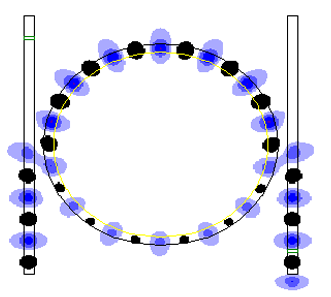Total internal reflection (TIR) is the optical phenomenon in which waves arriving at the interface (boundary) from one medium to another (e.g., from water to air) are not refracted into the second ("external") medium, but completely reflectedback into the first ("internal") medium. It occurs when the second medium has a higher wave speed (lower refractive index) than the first, and the waves are incident at a sufficiently oblique angle on the interface. For example, the water-to-air surface in a typical fish tank, when viewed obliquely from below, reflects the underwater scene like a mirror with no loss of brightness (Fig. 1).
TIR occurs not only with electromagnetic waves such as light and microwaves, but also with other types of waves, including sound and water waves. If the waves are capable of forming a narrow beam (Fig. 2), the reflection tends to be described in terms of "rays" rather than waves; in a medium whose properties are independent of direction, such as air, water or glass, the "rays" are perpendicular to the associated wavefronts.
Refraction is generally accompanied by partial reflection. When waves are refracted from a medium of lower propagation speed (higher refractive index) to a medium of higher speed—e.g., from water to air—the angle of refraction (between the outgoing ray and the surface normal) is greater than the angle of incidence (between the incoming ray and the normal). As the angle of incidence approaches a certain threshold, called the critical angle, the angle of refraction approaches 90°, at which the refracted ray becomes parallel to the boundary surface. As the angle of incidence increases beyond the critical angle, the conditions of refraction can no longer be satisfied, so there is no refracted ray, and the partial reflection becomes total. For visible light, the critical angle is about 49° for incidence from water to air, and about 42° for incidence from common glass to air.
Details of the mechanism of TIR give rise to more subtle phenomena. While total reflection, by definition, involves no continuing flow of power across the interface between the two media, the external medium carries a so-called evanescent wave, which travels along the interface with an amplitude that falls off exponentially with distance from the interface. The "total" reflection is indeed total if the external medium is lossless (perfectly transparent), continuous, and of infinite extent, but can be conspicuously less than total if the evanescent wave is absorbed by a lossy external medium ("attenuated total reflectance"), or diverted by the outer boundary of the external medium or by objects embedded in that medium ("frustrated" TIR). Unlike partial reflection between transparent media, total internal reflection is accompanied by a non-trivial phase shift (not just zero or 180°) for each component of polarization (perpendicular or parallel to the plane of incidence), and the shifts vary with the angle of incidence. The explanation of this effect by Augustin-Jean Fresnel, in 1823, added to the evidence in favor of the wave theory of light.
The phase shifts are utilized by Fresnel's invention, the Fresnel rhomb, to modify polarization. The efficiency of the total internal reflection is exploited by optical fibers (used in telecommunications cables and in image-forming fiberscopes), and by reflective prisms, such as image-erecting Porro/roof prisms for monoculars and binoculars.
https://en.wikipedia.org/wiki/Total_internal_reflection
An optical ring resonator is a set of waveguides in which at least one is a closed loop coupled to some sort of light input and output. (These can be, but are not limited to being, waveguides.) The concepts behind optical ring resonators are the same as those behind whispering galleries except that they use light and obey the properties behind constructive interference and total internal reflection. When light of the resonant wavelength is passed through the loop from input waveguide, it builds up in intensity over multiple round-trips due to constructive interference and is output to the output bus waveguide which serves as a detector waveguide. Because only a select few wavelengths will be at resonance within the loop, the optical ring resonator functions as a filter. Additionally, as implied earlier, two or more ring waveguides can be coupled to each other to form an add/drop optical filter.[1]
https://en.wikipedia.org/wiki/Optical_ring_resonators


No comments:
Post a Comment